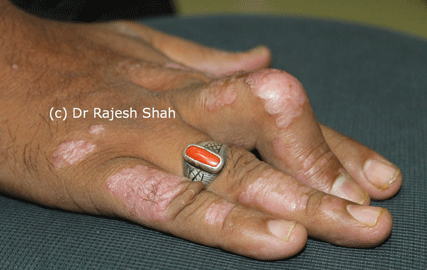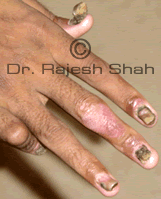What is Psoriatic Arthritis?
Psoriatic Arthritis is defined as an inflammatory condition of the joints (arthritis) associated with Psoriasis. Since in these cases, usually, the rheumatoid factor test is negative, Psoriatic Arthritis is called seronegative arthritis. Practically, in addition to all the symptoms of Rheumatoid arthritis, Psoriatic Arthritis also has psoriasis.
 Psoriatic Arthritis is an autoimmune disease and it affects the ligaments, tendons, fascia, and joints.
Psoriatic Arthritis is an autoimmune disease and it affects the ligaments, tendons, fascia, and joints.
Psoriasis is an obstinate skin condition in which red patches of various sizes develop on the skin that is covered with dry, silvery scales.
In psoriasis the skin becomes inflamed and red eruptions appear on the surface of the skin that begins to itch excessively. These areas form thickened areas (plaques) that are covered with silvery scales over the reddened lesions. The skin at the joints may crack.
Psoriasis most often occurs on the elbows, knees, scalp, lower back, palms, and soles of the feet. However, no area of the skin is exempt, including the genital area. The disease may also affect the fingernails and toenails. About 15 percent of people with psoriasis have joint inflammation that produces arthritis symptoms. This condition is called psoriatic arthritis.
When a patient's suffering from psoriasis develops pain, swelling, and inflammation in the joints, it is termed as psoriatic arthritis.
Any joint can be affected. The small joints, large joints or the spine can get affected.
A single or a few joints may get affected, or several small and big joints may be affected.
The typical picture is that of a patient suffering from psoriasis from several years suddenly develops acute joint pain and stiffness, thereby announcing the arrival of Psoriatic Arthritis.
Many patients develop arthritis after several years of suffering from psoriasis but a few patients develop arthritis in the early stage of psoriasis.
Patients with extensive psoriasis have more chances of developing psoriatic arthritis. However, mild cases of psoriasis may also present with psoriatic arthritis. Also, it is not a rule that all the cases of psoriasis will have psoriatic arthritis.
Some patients after using steroidal creams for psoriasis may see good relief in the skin, but may subsequently develop arthritis, as the disease goes deeper due to suppression of skin eruptions.
Some patients can develop psoriatic arthritis even with a mild form of skin psoriasis. And a few patients can develop psoriatic arthritis in the absence of psoriasis on the skin. (Seen in around 10 % cases)
In most patients, it is of a mild to moderate severity, but some patients will present with severe pain, restriction of movements, difficulty in walking and disability. In the severe forms, one can see deformity and destruction in the joints.
Flares and remissions usually characterize the course of psoriatic arthritis. Winter, Stress, and infections are likely to aggravate the condition.
Sex: Men and women are affected equally; men are more likely to be affected by the spondylitic form of psoriatic arthritis and females are more likely to be affected by the rheumatoid form.
Age: Psoriatic arthritis characteristically develops in persons aged 35-55 years, but it can occur in persons of almost any age.
The Psoriatic Nail
 About 50 percent of persons with active psoriasis have psoriatic changes in fingernails and/or toenails. In some instances, psoriasis may occur only in the nails and nowhere else on the body. Nail changes in psoriasis fall into general categories that may occur singly or all together:
About 50 percent of persons with active psoriasis have psoriatic changes in fingernails and/or toenails. In some instances, psoriasis may occur only in the nails and nowhere else on the body. Nail changes in psoriasis fall into general categories that may occur singly or all together:
- The nail plate is deeply pitted or depressed
- The nail has a yellow to yellow-pink discoloration
- White areas appear under the nail plate. There may be reddened skin around the nail.
- The nail plate crumbles in yellowish patches (onychodystrophy)
- The nail may be entirely lost
Psoriatic arthritis
Video on Psoriatic arthritis
Video on Psoriatic arthritis
Psoriatic arthritis is all the more difficult situations where you find psoriasis associated with joint pain (arthritis). This shows the deeper affection of the underlying problems. The changes in the blood which lead to psoriasis are now also bringing changes in the joints, which could even be irreversible. Any joint could be affected in this process. The joint affection relatively becomes more difficult to treat. Interestingly, there is a good treatment for psoriatic arthritis in homeopathy, especially if treated in the early stages. In the later stages, where deformities have taken place, homeopathy may only give relief in pain and swelling, but you cannot expect a complete cure of the disease.